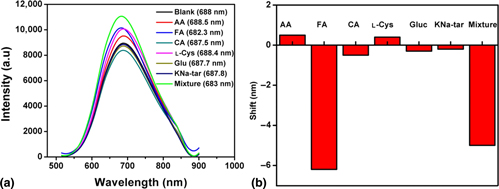Article contents
Selective detection of folic acid in the midst of other biomolecules using water-soluble AgInS2 quantum dots
Published online by Cambridge University Press: 16 September 2019
Abstract

We herein report the detection of folic acid (FA) via the fluorometric method using water-soluble AgInS2 quantum dots (QDs). The optical analysis showed that the addition of FA to AgInS2 QDs results in significant, blue-shifted photoluminescence emission. A linear plot of the blueshift in the photoluminescence wavelength position against FA concentration was obtained in the range of 0.03–33 µM with the detection limit of 52 nM. Interference study showed the selective detection of FA in the presence of other biomolecules. The as-synthesized AgInS2 QDs can be employed as an optical sensor for the rapid detection of FA in aqueous solutions.
- Type
- Research Letters
- Information
- Copyright
- Copyright © Materials Research Society 2019
References
- 6
- Cited by





